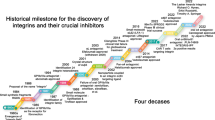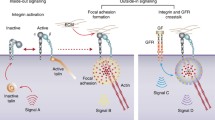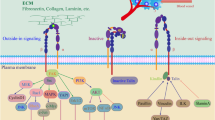Abstract
Integrins are cell surface adhesion molecules coupling the extracellular environment to the cytoskeleton as well as receptors for transmitting signals important for cell migration, invasion, proliferation, and survival. At least six integrin inhibitors are being evaluated in clinical trials for cancer. Currently, patients with melanoma and glioblastoma multiforme benefit from Vitaxin (MedImmune, Gaithersburg, MD) or cilengitide treatment, respectively. Many phase II trials are being or have been conducted with these two compounds (the most advanced). Surprisingly, despite the broad theoretical impact of such molecules on integrin function, and thus on pathology, the clear identification of discrete clinical niches for their use remains to be defined. Possible reasons for this are discussed in this review. The parallel development of integrin antagonists as imaging tools for patient selection may accelerate the discovery of new avenues for their use.
Similar content being viewed by others
References and Recommended Reading Papers of particular interest, published recently, have been highlighted as: Of importance Of major importance
Hynes RO: Integrins: bidirectional, allosteric signaling machines. Cell 2002, 110:673–687.
Haubner R, Finsinger D, Kessler H: Stereoisomeric peptide libraries and peptidomimetics for designing selective inhibiitors of the alphavbeta3 integrin for a new cancer therapy. Angew Chem Int Ed Engl 1997, 36:1374–1389.
Ginsberg MH, Partridge A, Shattil SJ: Integrin regulation. Curr Opin Cell Biol 2005, 17:509–516.
Stupack DG: Integrins as a distinct subtype of dependence receptors. Cell Death Differ 2005, 12:1021–1030.
Hood JD, Cheresh DA: Role of integrins in cell invasion and migration. Nature Rev Cancer 2002, 2:91–100.
Felding-Habermann B: Integrin adhesion receptors in tumor metastasis. Clin Exp Met 2003, 20:203–213.
Jin H, Varner J: Integrins: roles in cancer development and as treatment targets. Br J Cancer 2004, 90:561–565.
Reynolds LE, Wyder L, Lively JC, et al.: Enhanced pathological angiogenesis in mice lacking beta3 integrin or beta3 and beta5 integrins. Nat Med 2002, 8:27–34. Contrary to other knockouts for integrins involved in angiogenesis, the β3 and/or β5-null mice display a paradoxic angiogenic phenotype during tumor growth: instead of quenching blood vessel development in the tumor (or during other angiogenic events), vascularization is enhanced.
Hodivala-Dilke KM, Reynolds AR, Reynolds LE: Integrins in angiogenesis: multitalented molecules in a balancing act. Cell Tissue Res 2003, 314:131–144.
Castel S, Pagan R, Mitjans F, et al.: RGD peptides and monoclonal antibodies, antagonists of alphav-integrin, enter the cells by independent endocytic pathways. Lab Invest 2001, 81:1615–1626.
Mikecz K: Vitaxin. Curr Opin Investig Drugs 2000, 1:199–203.
Gutheil JC, Campbell TN, Pierce PR, et al.: Targeted antiangiogenic therapy for cancer using Vitaxin: a humanized monoclonal antibody to the integrin alphavbeta3. Clin Cancer Res 2000, 6:3056–3061.
Posey JA, Khazaeli MB, DelGrosso A, et al.: A pilot trial of vitaxin, a humanized anti-vitronectin receptor (anti alphavbeta3) antibody in patients with metastatic cancer. Cancer Biother Radiopharmac 2001, 16:125–132.
Patel SR, Jenkins J, Papadopolous N, et al.: Pilot study of Vitaxin — an angiogenesis inhibitor — in patients with advanced leiomyosarcomas. Cancer 2001, 92:1347–1348.
Hersey P, Sosman J, O’Day S, et al.: A phase II, randomized, open-label study evaluating the antitumor activity of MEDI-522, a humanized monoclonal antibody directed against the human alpha v beta 3 (alphavbeta3) integrin, ± dacarbazine (DTIC) in patients with metastatic melanoma (MM) [abstract]. Proc ASCO J Clin Oncol 2005, 23:7507. MEDI-522 is a second generation humanized version of LM609 with higher afffinity for αvβ3 than Vitaxin (now referred to as MEDI-523) was generally well tolerated, and clinical activity was shown in the absence or presence of dacarbazine, the current standard of care in advanced melanoma.
Sorbera LA, Graul A, Castañer J: Cilengitide. Drugs Fut 2000, 25:674–678.
Eskens FALM, Dumez H, Hoekstra R, et al.: Phase I and pharmacokinetic study of continuous twice weekly intravenous administration of cilengitide (EMD 121974), a novel inhibitor of the integrins alphavbeta3 and alphavbeta5 in patients with advanced solid tumours. Eur J Cancer 2003, 39:917–926.
Raguse J-D, Gath HJ, Bier J, et al.: Cilengitide (EMD 121974) arrests the growth of a heavily pretreated highly vascularised head and neck tumour. Oral Oncol 2004, 40:228–230. When standard treatments failed after several phases of rapid and massive growth, a combination of cilengitide and a cytostatic agent with a mild toxicity profile led to stabilization for 12 months on maintenance therapy with no tendency toward spontaneous bleeding. The disease state shifted from acute to chronic.
Colevas AD, Scharf O, Schoenfeldt M: Clinical trials referral resource. Current clinical trials of cilengitide, an alpha (v) antagonist in clinical development as an anticancer agent. Oncology (Williston Park) 2004, 18:1778, 1781–1782, 1784.
Public summary of positive opinion for orphan designation of cilengitide for the treatment of glioma. European Medicines Agency. Committee for orphan medicinal products. http://www.emea.eu.int/pdfs/human/comp/ opinion/032604en.pdf Accessed July 8, 2004.
Trikha M, Zhou Z, Nemeth JA, et al.: CNTO 95, a fully human monoclonal antibody that inhibits alphav integrins, has antitumor and antiangiogenic activity in vivo. Int J Cancer 2004, 110:326–335.
Jayson GC, Mullamitha S, Ton C, et al.: Phase I study of CNTO 95, a fully human monoclonal antibody (mAb) to alphav integrins, in patients with solid tumors [abstract]. Proc ASCO J Clin Oncol 2005, 23:3113.
Livant DL, Brabec RK, Pienta KJ, et al.: Anti-invasive, antitumorigenic, and antimetastatic activities of the PHSCN sequence in prostate carcinoma. Cancer Res 2000, 60:309–320.
Plunkett ML, Tel-Tsur Z, Bera M, et al.: A novel anti-angiogenic/ anti-metastatic peptide, ATN-161 (Ac-PHSCN-NH2), which targets multiple fully activated integrins including alpha-5 beta-1 and alpha-v beta-3, leads to increased antitumor activity and increased survival in multiple tumor models when combined with chemotherapy [abstract]. Eur J Cancer 2002(Suppl 7):249.
Plunkett ML, Mazar AP: Dose and schedule optimization of a novel anti-angiogenic/anti-metastatic peptide, ATN-161 (Ac-PHSCN-NH2), which targets multiple fully activated integrins including alpha-5 beta-1 and alpha-v beta-3 [abstract]. Eur J Cancer, 2002(Suppl. 7):262.
Stoeltzing O, Liu WB, Reinmuth N, et al.: Inhibition of integrin alpha(5)beta(1) function with a small peptide (ATN-161) plus continuous 5-FU infusion reduces colorectal liver metastases and improves survival in mice. Int J Cancer 2003, 104:496–503.
Rabbani SA, Khalili P, Mazar AP: A non-RGD based integrin binding peptide (ATN-161) that targets activated alpha-5 beta-1 and alpha-v beta-3 blocks the development of osteolytic skeletal metastases in a xenograft model of breast cancer [abstract]. Clin Cancer Res 2003, 9(Suppl):6181.
Khalili P, Plunkett M, Beck I, et al.: Regression of primary breast tumor and blockage of osteolytic skeletal metastasis by a non-RGD based integrin binding peptide (ATN-161) targeting α5β1 and αvβ3 in a xenograft model of breast cancer [abstract]. Proc AACR 2004, 45:4001.
Ramakrishnan V, Johnson DE, Wills M, et al.: A function-blocking chimeric antibody, Eos200-4, against alpha5beta1 integrin inhibits angiogenesis in a monkey model [abstract]. Proc AACR, 2003(ed 44):2052.
Ricart A, Liu G, Tolcher A, et al.: A phase I dose-escalation study of anti-alpha5beta1 integrin monoclonal antibody (M200) in patients with refractory solid tumors [abstract]. Eur J Cancer 2004 2(Suppl):166.
Funahashi Y, Sugi NH, Semba T, et al.: Sulfonamide derivative, E7820, is a unique angiogenesis inhibitor suppressing an expression of integrin alpha2 subunit on endothelium. Cancer Res 2002, 62:6116–6123.
Semba T, Funahashi Y, Ono N, et al.: An angiogenesis inhibitor E7820 shows broad-spectrum tumor growth inhibition in a xenograft model: possible value of integrin alpha2 on platelets as a biological marker. Clin Cancer Res 2004, 10:1430–1438.
Mita MM, Mita AC, Goldston M, et al.: Pharmacokinetics (PK) and pharmacodynamics (PD) of E7820-an oral sulfonamide with novel, alpha-2 integrin mediated antiangiogenic properties: Results of a phase I study [abstract]. Proc ASCO J Clin Oncol 2005, 23:3082.
Folkman J: Endogenous angiogenesis inhibitors. APMIS 2004, 112:496–507.
Nyberg P, Xie L, Kalluri R: Endogenous inhibitors of angiogenesis. Cancer Res 2005, 65:3967–3979.
MacDonald TJ, Taga T, Shimida H, et al.: Preferential susceptibility of brain tumors to the antiangiogenic effects of an alphav integrin antagonist. Neurosurgery 2001, 48:151–157. Cilengitide cured mice xenotransplanted with human brain tumor cell lines.
Haubner R, Wester H-J, Weber WA, et al.: Noninvasive imaging of alphavbeta3 integrin expression using 18F-labeled RGD-containing glycopeptide and positron emission tomography. Cancer Res 2001, 61:1781–1785. M21 human melanoma tumors grafted in mice are visualized by positron emission tomography and a radioactive tracer for the αvβ3 integrin because the tumor cells express αv integrin, but there is no staining of M21-L tumours (αv-negative tumor cells). This suggests that host endothelial cells do not express the αv integrins, although it may be argued that the compound may not recognize low amounts of the integrin on endothelial cells.
Hamano Y, Zeisberg M, Sugimoto H, et al.: Physiological levels of tumstatin, a fragment of collagen IV beta3 chain, are generated by MMP-9 proteolysis and suppress angiogenesis via alphavbeta3 integrin. Cancer Cell 2003, 3:589–601. Through the use of an antibody recognizing the mouse β3 subunit, it was shown that quiescent endothelial cells are not reacting with this antibody, but the same was true for endothelial cells involved in liver regeneration or wound healing. As for tumor endothelial cells, the expression was found only in large tumors, thus pointing to distinct angiogenic mechanisms as a function of tumor development.
Taga T, Suzuki A, Gonzalez-Gomez I, et al.: Alphav-integrin antagonist EMD 121974 induces apoptosis in brain tumor cells growing on vitronectin and tenascin. Int J Cancer 2002, 98:690–697.
Harms JF, Welch DR, Samant RS, et al.: A small molecule antagonist of the alphavbeta3 integrin suppresses MDA-MB-435 skeletal metastasis. Clin Exp Metast 2004, 21:119–128. Treatment with the S247 αvβ3 integrin antagonist leads to reduced bone metastasis in a breast cancer model, but significant effects are only seen when the compound is administered during the early hematogenous phase of metastasis implantation. Later treatment when tumor cells are implanted shows only a trend toward inhibition of bone metastases.
Shannon KE, Keene JL, Settle SL, et al.: Anti-metastatic properties of RGD-peptidomimetic agents S137 and S247. Clin Exp Metast 2004, 21:129–138. The S137 αv integrin antagonist was applied in a setting closer to the clinic. A breast carcinoma cell line was implanted into the mammary fat pad, and treatment began 4 weeks later concomitantly with primary tumor resection. Under these conditions, the compound administered orally twice a day could still reduce significantly the lung metastatic tumor burden.
Nemeth JA, Cher ML, Zhou Z, et al.: Inhibition of alphavbeta3 integrin reduces angiogenesis, bone turnover, and tumor cell proliferation in experimental prostate cancer bone metastases. Clin Exp Metast 2003, 2:413–420.
Pecheur I, Peyruchaud O, Serre CM, et al.: Integrin alpha(v)beta3 expression confers on tumor cells a greater propensity to metastasize to bone. FASEB J 2002, 16:1266–1268.
Haubner R, Weber WA, Beer AJ, et al.: Noninvasive visualization of the activated alphavbeta3 integrin in cancer patients by positron emission tomography and [18F]Galacto-RGD. PloS Med 2005, 2:e70. The use of an αvβ3-antagonist coupled to a radioactive tracer for molecular imaging reveals the possibility of selecting patients prior to anti-angiogenic therapies targeting the αvβ3 integrin.
Lode HN, Moehler T, Xiang R, et al.: Synergy between an antiangiogenic integrin alphav antagonist and an antibodycytokine fusion protein eradicates spontaneous tumor metastases. Proc Natl Acad Sci U S A 1999, 96:1591–1596.
Burke PA, DeNardo SJ, Miers LA, et al.: Cilengitide targeting of alphavbeta3 integrin receptor synergizes with radioimmunotherapy to increase efficacy and apoptosis in breast cancer xenografts. Cancer Res 2002, 62:4263–4272.
Nurden AT, Nurden P: GPIIb/IIIa antagonists and other anti-integrins. Semin Vasc Med 2003, 3:123–130.
Cohen SA, Trikha M, Mascelli MA: Potential future clinical applications for the GPIIb/IIIa antagonist, abciximab in thrombosis, vascular and oncological indications. Pathol Oncol Res 2000, 6:163–174.
Berger JR, Koralnik IJ: Progressive multifocal leukoencephalopathy and natalizumab: unforeseen consequences. N Engl J Med 2005, 353:414–416. Natalizumab was withdrawn recently from the market after it was reported that three patients out of 3000 died of progressive multifocal leukoencephalopathy (PML) in long-term clinical trials for multiple sclerosis or Crohn’s disease. It appears that by inhibiting normal lymphocyte trafficking, the antibody may have enabled the viral replication of the JC polyomavirus responsible for PML, a virus commonly found in adults.
Hurwitz H, Fehrenbacher L, Novotny W, et al.: Bevacizumab plus irinotecan, fluorouracil, and leucovorin for metastatic colorectal cancer. N Eng J Med 2004, 350:2335–2342.
Ferrara N, Hillan KJ, Gerber H-P, et al.: Discovery and development of bevacizumab, an anti-VEGF antibody for treating cancer. Nat Rev Drug Discov 2004, 3:391–400.
Hood JD, Bednarski M, Frausto R, et al.: Tumor regression by targeted gene delivery to the neovasculature. Science 2002, 296:2404–2407.
Stupack DG, Cheresh DA: Integrins and angiogenesis. Curr Top Dev Biol 2004, 64:207–238.
McNeel DG, Eickhoff J, Lee FT, et al.: Phase I trial of a monoclonal antibody specific for alphavbeta3 integrin (MEDI-522) in patients with advanced malignancies, including an assessment of effects on tumor perfusion. Clin Cancer Res 2005, 11:7851–7860. MEDI-522 exhibits greater manufacturing stability and a higher affinity for the αvβ3 integrin than Vitaxin (MEDI-523). No objective responses were identified, but prolonged stable disease for more than 34 weeks was observed in three patients with metastatic renal cancer.
Martin PL, Jiao Q, Cornacoff J, et al.: Absence of adverse effects in cynomolgus macaques treated with CNTO 95, a fully human anti-alphav integrin monoclonal antibody, despite widespread tissue binding. Clin Cancer Res 2005, 11:6959–6965.
Author information
Authors and Affiliations
Corresponding author
Rights and permissions
About this article
Cite this article
Tucker, G.C. Integrins: Molecular targets in cancer therapy. Curr Oncol Rep 8, 96–103 (2006). https://doi.org/10.1007/s11912-006-0043-3
Issue Date:
DOI: https://doi.org/10.1007/s11912-006-0043-3




